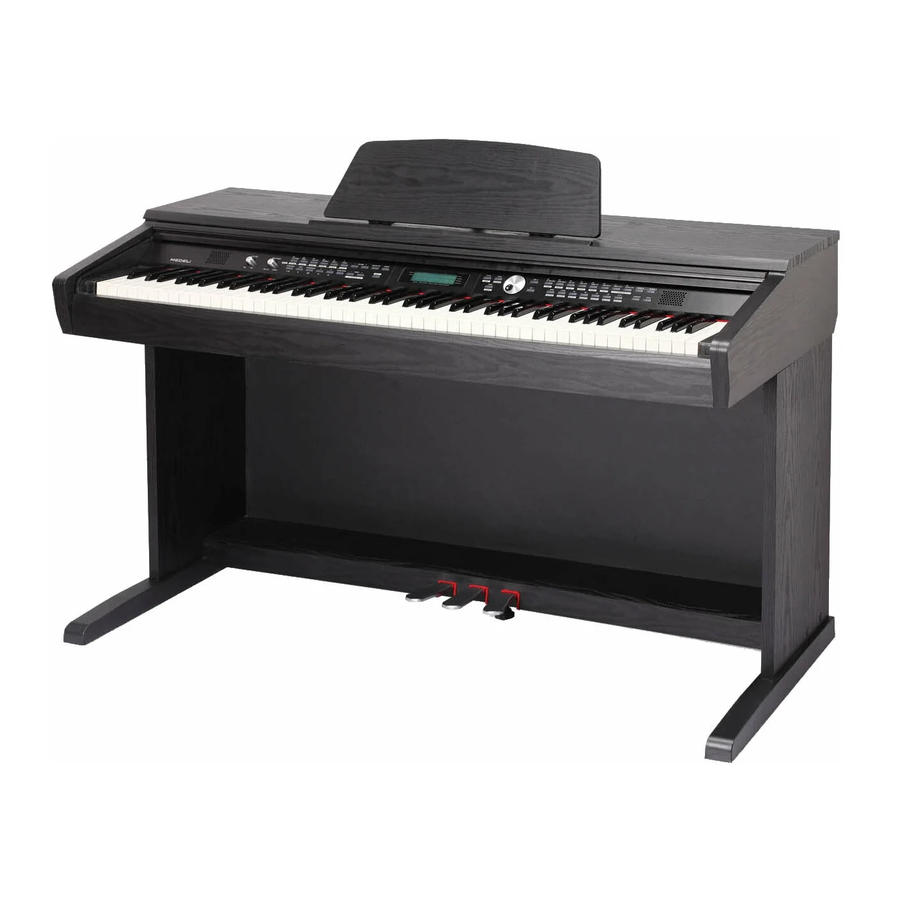
Table of Contents
Advertisement
Quick Links
Advertisement
Table of Contents

Summary of Contents for Medeli DP88
- Page 2 Using the Instruction Manual Thank you for purchasing this Digital Piano. The use of high technology and the most advanced sampling technique brings you high quality sound and enjoyment. The combination of digital piano and electronic keyboard features let you perform perfectly. We hope this skilfully built digital piano will able to explore your creativity, and brings you unlimited happiness and music enjoyment.
-
Page 3: Table Of Contents
Contents Digital Piano Set-up Guide General Guide The Connectors - Using the AC power jack - Using Headphones - Using the MIDI OUT jack Operation 9-13 1. Power Switch & Volume 2. Voice/Dual Voic e 3. Metronome 4. DSP (Digital Signal Processor) 5. -
Page 4: Digital Piano Set-Up Guide
Digital Piano Set-up Guide 1. Open the package, and check whether the following parts are available: 1. Piano body 6. Foot pedal unit 2. Music stand 7. Hand screw (4 pcs.) 3. Right leg component 8. Screws (8 pcs.) 4. Left leg component 9. - Page 5 Digital Piano Set-up Guide 2. Follow the illustration below and finish off the set-up procedures. A. Put the foot pedal unit(6) in between the left and right legs components (3&4) . Use 4 pieces of screws (2 on each side) to stable the legs onto the foot pedal unit. (Make sure the direction of the placement is correct before screwing) B.
- Page 6 Digital Piano Set-up Guide C. Put the piano body(1) on the top of the finished assembly in part B. Use 4 pieces of hand screws to stable afterward. D. After the initial set-up, stick the cable stabling hook(10) on the internal side of the leg component (see the below illustration for reference).
-
Page 7: General Guide
General Guide Top View Rear View Front View Control Panel Soft Pedal MIDI OUT Jack Sustain Pedal Headphones Jack Piano Keyboard Music Stand... - Page 8 General Guide POWER SWITCH VOICE TYPE & DEMO SONG SELECT MASTER VOLUME 0 - PIANO 1 DUAL 1 - PIANO 2 2 - E.PIANO 1 TOUCH 3 - E.PIANO 2 RECORD 4 - HARPSICHORD TRACK A 5 - VIBES TRACK B 6 - STRINGS ENSEMBLE REPEAT 7 - CHORUS...
-
Page 9: The Connectors
The Connectors Using the AC power jack Ensure the piano Turn the volume switch is turned off when anti-clockwise to reach connecting and the minimum volume disconnecting the level. power. Plug the power cable If you have done the above into an AC power procedures, you are now safe to outlet. -
Page 10: Operation
Operation 1. Power Switch & Volume 2. Use the volume control 1. Turn the POWER switch on. switch to adjust the The LED display lightens up. volume to your desired level Caution: If the LED display has not lightened up after you turned on the piano, please check the power supply. -
Page 11: Dsp (Digital Signal Processor)
Operation 4. DSP (Digital Signal Processor) Press the [DSP] button to turn on/off the DSP. The status will appear on the LED. 5. Transpose The Transpose function allows you to change the pitch of the instrument in semi-tone steps, up to a maximum setting of 12 semitones above or below standard pitch. -
Page 12: Touch Response
Operation 7. Touch Response There is touch response function and it is a default setting. Press the [TOUCH] button to adjust the touch response level in the range of 1 to 3. 2 is the default level. To turn off the touch response function, press the [TOUCH] button repeatedly until "OFF"... -
Page 13: Demo Song
Operation Repeat the playback During the playback, press the [REPEAT] button to set the point of beginning that you want to listen, "r-A" will appear on the display, then press the [REPEAT] button again to set the end point of the playback, "r-B" will appear on the display and the recorded song will playback repeatedly. -
Page 14: Foot Pedals
Operation Repeat the demo song When a demo song is playing , press the [REPEAT] button to set the point of beginning that you want to listen. "r-A" will appear on the display, then press the [REPEAT] button again to set the end point of the playback. -
Page 15: Midi
MIDI The MIDI OUT terminals, which is located at the rear panel of the unit. The following shows the description of MIDI and the steps of using MIDI function. What is MIDI? MIDI stand for Musical Instrument Digital Interface. MIDI is a world wide standard that makes it possible for various electronic musical instruments and other devices, such as computers, to "communicate with each other". -
Page 16: Specifications
Specifications Keyboard 88 hammer action keys Voice 10 Voices Demo Song 20 Demo Songs Display Switch and Buttons POWER SWITCH, VOLUME SWITCH, DUAL, DSP, TOUCH, RECORD, TRACK A, TRACK B, REPEAT, METRONOME, TRANSPOSE +/-, TEMPO +/-, DEMO ALL, RECORD - PLAY/STOP, DEMO - SELECT/ START/STOP, VOICE SELECT 0-9 Transpose 12 semi tones... -
Page 17: Voice List
Voice List Name of Voice Name of Voice on Panel Demo Song List...














Need help?
Do you have a question about the DP88 and is the answer not in the manual?
Questions and answers